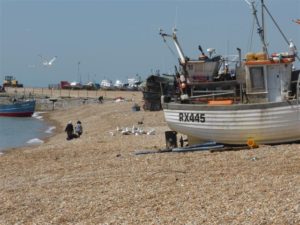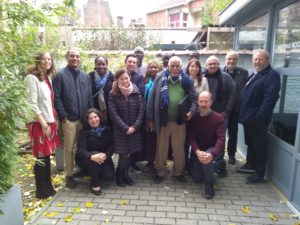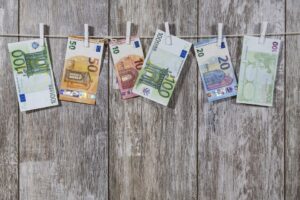Covid-19 i malo ribarstvo
Kolaps tržišta i ribari bez socijalne zaštite
Bruxelles, 3. travnja 2020.
Prošle srijede, 1. travnja, Virginijus Sinkevičius, povjerenik za okoliš, oceane i ribarstvo, kontaktirao je LIFE kako bi ga upitao kako se sektor malog ribarstva nosi s krizom uzrokovanom pandemijom Covida-19. LIFE je naglasio da veliki dio flote malog ribarstva pokušava ostati aktivan, održati egzistenciju i osigurati lokalno ulovljenu svježu ribu, ali se suočava s ogromnim poteškoćama u tome. S obzirom na to da su mnoga tržišta zatvorena, veleprodajne cijene svježe ribe su pale, a ograničen je pristup skladištima i alternativnim marketinškim objektima. Ribari se također suočavaju s poteškoćama u ispunjavanju novih sanitarnih zahtjeva i mjera socijalnog distanciranja. Zbog tih poteškoća, veliki dio flote bio je prisiljen pristati.
Povjerenik je obavijestio LIFE o novim hitnim mjerama koje se uvode izmjenama i dopunama uredbe o EFPR-u (https://eur-lex.europa.eu/legal-content/EN/TXT/?uri=COM:2020:142:FIN). One su osmišljene kako bi državama članicama olakšale pristup EFPR-u za privremeno zatvaranje aktivnosti i pomoć za skladištenje. Pojedinosti o ovim i drugim novim mjerama dostupne su putem poveznice https://ec.europa.eu/fisheries/coronavirus-response-fisheries-and-aquaculture_en.
U svojoj komunikaciji Komisija ističe da su mali obalni ribari i proizvođači ribe posebno teško pogođeni krizom.
LIFE je objasnio da za one koji žele ostati aktivni to nije od pomoći; da će zapravo pomoć za skladištenje najvjerojatnije imati depresivan učinak na cijene ribe nakon što kriza popusti. Ono što aktivnim ribarima najviše treba jest potpora prihodima i podrška za izravnu prodaju ribe potrošačima. Povjerenik je odgovorio da se takva potpora može pružiti samo na razini država članica. Komisija bi mogla pomoći samo korištenjem raspoloživih sredstava kako bi državama članicama omogućila veću fleksibilnost u odgovoru na krizu.
Naglasio je važnu ulogu koju mala flota s niskim utjecajem ima za lokalna gospodarstva i održavanje društvenih i ekoloških aspekata ribarstva. Bio je prijateljski nastrojen i zabrinut. Zamolio je da ga se obavještava.
Jerry Percy, viši savjetnik u organizaciji LIFE i direktor Udruge ribara za djecu mlađu od deset godina [NUTFA], poslao nam je svoje osobno mišljenje o situaciji u Ujedinjenom Kraljevstvu:
Utjecaj globalne pandemije Covid-19 na ribarstvo Ujedinjenog Kraljevstva
Kao i gotovo svaki drugi element britanske industrije, ribarski sektor, kroz cijeli lanac opskrbe, od mreže do tanjura, predstavlja kaos epskih razmjera, a učinci pandemije nastavit će imati ogromne ekonomske posljedice u doglednoj budućnosti. Međutim, za mnoge brodove u britanskoj floti, porast potražnje za izravnom prodajom svježe ribe ne samo da pruža spas, već bi se nadamo da mogao biti početak renesanse interesa za kupnju svježe ribe od strane kućanstava koja su rijetko, ako ikada, imala hrabrosti kupiti ribu koja već nije prekrivena krušnim mrvicama.
——————————————————–
Utjecaj koronavirusa gotovo je preko noći uvelike desetkovao tvrtke koje se oslanjaju na visokokvalitetne proizvode poput ulovljenih kapica, jastoga i rakova, dok su cijene glavnih vrsta riba pale.
Velika većina posada na malim brodovima, kraćim od deset metara, plaća se na temelju udjela u plaćama i čini se da su ekonomski jednako ranjive kao i one u gig ekonomiji u odnosu na uvjete financijske potpore, ili njihov nedostatak, koje je vlada objavila u vrijeme pisanja ovog teksta. Proporcionalno više posada u sektoru brodova dužih od deset metara zaposleno je s plaćom i stoga ima pristup financijskoj potpori, no ipak je nedostatak izravne financijske potpore samozaposlenima razlog za zabrinutost bez obzira na veličinu broda.
S obzirom na to da cijene brodova koji pristaju na tržište padaju iz trenutka u trenutak, primjerice snažan ulov bakalara pao je na 0,41 funtu po kilogramu na tržnici Newlyn, nakon što je prethodnih tjedana u prosjeku iznosio oko 4 funte, a s obzirom na to da je kapetan jednog broda iskrcao značajnu količinu te vrste, unajmivši kvotu od 0,50 funti po kilogramu kako bi je uopće ulovio, mnogi brodovi se vežu umjesto da gube novac. Trgovci i prerađivači, odražavajući gubitak mnogih izvoznih tržišta, kao i smanjenu domaću potražnju, posebno u sektoru prehrambenih usluga, nisu bili skloni platiti dobar novac za ribu s kojom bi se potom mogli zaglaviti. Problem je bio još veći, neki prerađivači su prodali dio svojih smrznutih zaliha kako bi smanjili režijske troškove, što je dodatno pritisnulo na cijene. I da stvar bude gora, mnogi veći trgovci, koji su već smanjili radno vrijeme svojih štandova sa svježom ribom, odlučili su ih potpuno zatvoriti zbog nedostatka osoblja i, pretpostavljam, nestabilnosti zaliha.
Prve prodajne cijene za košaricu vrsta:

Gornji grafikon ilustrira smanjenje cijena prve prodaje proizvoljnog raspona vrsta i veličina u posljednjih nekoliko mjeseci. Nipošto nije znanstven i zanemaruje količine ribe koja se iskrcava po danu, ali odražava vrstu iskrcaja s mnogih obalnih brodova na južnoj obali.
Opseg, brzina i ozbiljnost pada potražnje, a time i cijena, očito su šokirali mnoge proizvođače, prerađivače i trgovce, većim dijelom zbog gubitka primarnog tržišta za ribu u Ujedinjenom Kraljevstvu, sektora usluživanja hrane. Činjenica je da potrošnja svježe ribe u Ujedinjenom Kraljevstvu pada već godinama, iz raznih razloga, uključujući promjene u radnim praksama, dostupnost prikladno nazvane i visoko prerađene gotove hrane, uključujući proizvode na bazi ribe, te rastuće neznanje o tome što učiniti za pripremu svježe ribe. Stara izreka da britanski potrošač neće ništa dirati očima ili pulsom posebno vrijedi za ribu.
ALI, iz svih ovih nedaća proizašla je gotovo preko noći promjena u uobičajenim procesima i logistici lanca opskrbe oko prodaje ribe potrošačima u Ujedinjenom Kraljevstvu.
Potražnja za etabliranim uslugama dostave ribe u kutijama naglo je porasla, a ponuda se muči držati korak s naletom narudžbi. Sa sjedištem u Plymouthu, Sole of Discretion, [ https://soleofdiscretion.co.uk/ ] dobavljač etički nabavljene ribe koju oni ili neke od poznatih dostavnih službi dostavljaju na vaša vrata zabilježio je znatno povećanu potražnju, a Pesky Fish u Londonu [ https://www.peskyfish.co.uk/ ]čiji revolucionarni pristup lancu opskrbe povezuje kupce s isporukom istog dana izravno s obalnih brodova svakodnevno je privukao stotine novih domaćih kupaca.
Ova velika promjena u domaćoj potražnji za visokokvalitetnom svježom ribom u mnogim je područjima popraćena povećanom potražnjom kod ribarnica diljem zemlje.
Iako ove promjene od male, ako ikakve, koristi proizvođačima skupih školjaka, za mnoge brodove u britanskoj floti to jest ili se barem čini da jest ne samo spas u smislu održavanja brodova na moru, već se nadamo i početak renesanse interesa za kupnju svježe ribe od strane kućanstava koja su rijetko, ako ikada, imala hrabrosti kupiti ribu koja već nije prekrivena krušnim mrvicama.
Istovremeno, pomorske dobrotvorne organizacije pojačale su svoju podršku ribarskom sektoru.
Nedavne studije koje je naručila vodeća organizacija u području pomorskih dobrotvornih organizacija, Seafarers UK, [ https://www.seafarers.uk/news/seafarers-uk-statement-on-covid-19/ ]već su identificirali društvene, mentalne, ekonomske i fizičke izazove s kojima se suočavaju mnogi u sektoru priobalja te su, zajedno s Misijom ribara [ https://www.fishermensmission.org.uk/ ], Tvrtka za ribarstvo [ https://fishmongers.org.uk/ ], linija za savjetovanje i informiranje pomoraca [ http://sailine.org.uk/ ]i mnoge druge dobrotvorne organizacije suočile su se sa sve većim izazovima s kojima se ribari suočavaju u ovom trenutku.
Kao i uvijek, Uprava za industriju morskih riba [ https://www.seafish.org/article/coronavirus-updates-for-the-seafood-industry ], koordinira informacije i savjete te usmjerava podršku ribarima diljem Ujedinjenog Kraljevstva, kao i pruža informacije raznim vladinim odjelima u vezi sa specifičnim izazovima s kojima se suočava ribarski sektor u cijelosti.
DEFRA je osnovala Radnu skupinu za Covid-19 u ribarskoj industriji kako bi osigurala da su im dostupni ažurirani obavještajni podaci iz cijelog spektra ribarske industrije, a i westminsterska i škotska vlada očito aktivno razmatraju načine podrške svojim ulovnim ribarima. [Napomena: u vrijeme pisanja teksta postoje snažne glasine o podršci ulovnim ribarima i samozaposlenima, ali još ništa konkretno. Možemo se samo nadati da će vlada biti dobra ili nećemo imati puno obalnog sektora nakon virusa].
Kao dio grupe, lobirali smo kod vlade za ublažavanje kvota za ribare školjki koji ne mogu prodavati rakove i jastoge, ublažavanje ograničenja od 30 kg dnevno za izravnu privatnu prodaju ribara i sličan pristup koji bi ribarima omogućio preradu i prodaju ribe uz osiguranje sigurnih i higijenskih praksi.
Glavna potreba za sektor ribolova i dalje je poštena ponuda za sve ribare koji dijele ulov i samozaposlene. S obzirom na nedavne zahtjeve za izbjegavanje bliskog kontakta, mnogi će brodovi biti prisiljeni vezati se jer je naravno nemoguće samoizolirati se na brodu ili ostati dva metra udaljeni jedni od drugih!
Osim toga, u tijeku je ili se razvija širok raspon lokalnih i nacionalnih inicijativa kako bi se zadovoljila rastuća potražnja za dostavom ribe na kućnu adresu. One se kreću od oglašavanja pojedinačnih ribara na internetu do većih kooperativnih pristupa kao što su:
https://www.seafoodcornwall.org.uk/fishtoyourdoor/ [s izvrsnim savjetima za ribare koji žele izravno prodati svoj ulov].
https://docs.google.com/forms/d/1f8A49PKZgJ9gnaRPNN0XRIw71XEsrf7scqI1vb3urco/edit#responses
https://www.bluemarinefoundation.com/2020/03/18/fisherman-face-hard-times-but-the-public-can-help/
i mnogi drugi. I naravno, brojni ribari okreću se dostavi na kućnu adresu, kao i zadržavanju dobro opskrbljenih trgovina: http://www.fishmongers.info/find/find.php
Seafish je zajedno s DEFRA-om pokrenuo svoju kampanju Sea for Yourself u ožujku ove godine i iako se možda smatralo da je to bio nesretan trenutak, zapravo je pravovremen za podupiranje očito rastućeg interesa za kupnju i kuhanje svježe ribe [ https://www.seafish.org/article/sea-for-yourself Osim toga, prerađivači žele ponuditi više pakiranih svježih ribljih proizvoda za rashladne vitrine velikih trgovaca, a oni će sadržavati poveznicu na web stranicu Seafish za recepte i savjete za kuhanje.
Dakle, kao i gotovo svaki drugi element britanske industrije, ribarski sektor, kroz cijeli lanac opskrbe, od mreže do tanjura, predstavlja kaos epskih razmjera, a učinci pandemije nastavit će imati ogromne ekonomske reperkusije u doglednoj budućnosti.
U međuvremenu, mnogi ribari se bore, još uvijek odlazeći na more kako bi iskrcali ribu za ono što možemo samo nadati se da je brzo rastuće domaće tržište.







 U video obraćanju na sastanku
U video obraćanju na sastanku Marja Bekendam, odlazeća predsjednica Aktee, istaknula je napredak koji su ženske organizacije postigle tijekom 10-godišnjeg razdoblja u kojem je predsjedavala Akteom. Naglasila je da unatoč ovom napretku još uvijek ima dug put pred sobom, posebno kako bi se žene značajnije uključile u Savjetodavna vijeća i bolje integrirale u druga tijela koja donose odluke.
Marja Bekendam, odlazeća predsjednica Aktee, istaknula je napredak koji su ženske organizacije postigle tijekom 10-godišnjeg razdoblja u kojem je predsjedavala Akteom. Naglasila je da unatoč ovom napretku još uvijek ima dug put pred sobom, posebno kako bi se žene značajnije uključile u Savjetodavna vijeća i bolje integrirale u druga tijela koja donose odluke.

 S obzirom na kratko vrijeme provedeno u mrežama, kvaliteta ribe je vrlo dobra. Budući da je jedini pogon potreban za lokaciju i okruženje jata riba, a budući da su mreže vrlo lagane, potrošnja energije je niska. Još jedna velika prednost alata za ribolov je relativno nizak usputni ulov. Velika veličina oka mreže također osigurava da je riba 99% iznad minimalne veličine za iskrcavanje.. Jasan slučaj prave opreme, za pravo mjesto u pravo vrijeme.
S obzirom na kratko vrijeme provedeno u mrežama, kvaliteta ribe je vrlo dobra. Budući da je jedini pogon potreban za lokaciju i okruženje jata riba, a budući da su mreže vrlo lagane, potrošnja energije je niska. Još jedna velika prednost alata za ribolov je relativno nizak usputni ulov. Velika veličina oka mreže također osigurava da je riba 99% iznad minimalne veličine za iskrcavanje.. Jasan slučaj prave opreme, za pravo mjesto u pravo vrijeme.









